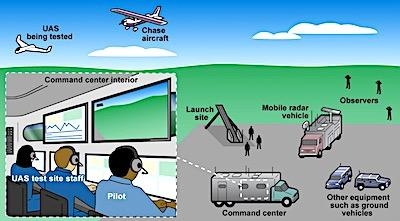Recommends That The FAA Develop A Data Analysis Plan For Test Site Data, Share More Information
The Government Accountability Office (GAO) was asked to review FAA’s management of the test sites. The report generated by the review examines, among other things: (1) the research conducted at FAA’s designated UAS test sites, and (2) how FAA is leveraging and sharing information from the test site program to advance integration. GAO reviewed relevant statutes and regulations, reports, and FAA guidance; analyzed test sites’ efforts, including flight test data submitted to FAA from 2015 through 2018; and interviewed FAA officials, test site representatives from all 7 test sites, and 18 test site users, selected to include a range of perspectives.

UAS could provide significant economic and social benefits, for example by delivering packages or aiding in search and rescue missions. FAA is conducting a phased approach to incrementally integrate UAS safely into the national airspace. As directed by statute, FAA established UAS test sites to allow industry to assess the safety and feasibility of complex UAS operations, such as flying beyond an operator’s line of sight. FAA has stated that this program provides research results and other data needed to reach full integration.
The GAO found that the FAA's seven designated test sites for unmanned aircraft systems (UAS) have facilitated about 15,000 UAS flight tests since 2015 and supported a wide range of research. Both public and private entities have used the test sites to test technologies in preparation for varied UAS activities, from inspecting utilities to carrying passengers. Research conducted at test sites provides data on the performance of various UAS capabilities and technologies; such data could support the FAA’s integration efforts.
While the FAA collects this data from test sites, it has not fully leveraged the data or the program to advance UAS integration. According to the FAA’s 2018 Roadmap for UAS Integration a key goal of this program is to provide data to support the FAA’s decisions on drone integration. FAA officials said the agency intends to use the data to a greater extent in the future to advance integration. Without an analysis plan, however, the FAA could miss opportunities to better use the data to inform the overall integration effort, such as to inform UAS operational standards. Also, the FAA reports limited public information about how test sites’ research relates to the agency’s integration plans. Agency officials told GAO they were wary of sharing more information about the test sites, citing concerns about, among other things, protecting test site users’ proprietary data. All test site representatives and most users GAO interviewed, however, said that more information on test
sites’ research would be helpful for UAS stakeholders’ research efforts. According to the FAA plans, the agency must rely on relationships with stakeholders across government and industry to ensure that integration efforts are harmonized. By sharing more information publicly, the FAA could demonstrate to such stakeholders how the agency is fostering and using research to inform and advance integration. Further, with more information, more stakeholders may opt to use a test site to conduct their own research, thus potentially increasing data available to the FAA to inform its integration decisions.
The GAO recommends that FAA (1) develop a data analysis plan for test site data and 2) share more information on how this program informs integration, while protecting proprietary data. The FAA partially agreed with the first recommendation and agreed with the second. GAO added language to the first recommendation to address the issue that the FAA raised, as discussed in this report.
(Infographic provided with GAO report)
 ANN's Daily Aero-Term (04.26.24): DETRESFA (Distress Phrase)
ANN's Daily Aero-Term (04.26.24): DETRESFA (Distress Phrase) ANN's Daily Aero-Linx (04.26.24)
ANN's Daily Aero-Linx (04.26.24) Airborne 04.22.24: Rotor X Worsens, Airport Fees 4 FNB?, USMC Drone Pilot
Airborne 04.22.24: Rotor X Worsens, Airport Fees 4 FNB?, USMC Drone Pilot Airborne 04.24.24: INTEGRAL E, Elixir USA, M700 RVSM
Airborne 04.24.24: INTEGRAL E, Elixir USA, M700 RVSM Airborne-NextGen 04.23.24: UAVOS UVH 170, magni650 Engine, World eVTOL Directory
Airborne-NextGen 04.23.24: UAVOS UVH 170, magni650 Engine, World eVTOL Directory



